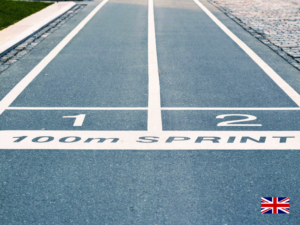
Why Sales is a Marathon, Not a Sprint
On Sunday morning, thousands of serious runners and fun runners will gather in Blackheath to begin the 37th London Marathon. Some will be dressed in running shorts and vests, others as superheroes or Teletubbies. On the surface, running and selling might not have very much in common, but as you explore the ways prospecting, sales and running are similar, it’s very clear that sales is definitely a marathon, not a sprint.
It’s about endurance and persistence
You’ve probably heard that it takes somewhere between 8 and 12 “touches” to get a prospect to understand what you offer and how it will benefit them. As a sales professional, you know that it makes sense to spread these points of contact out over a few weeks because the timing matters. If you called and emailed the same prospect every hour for a day there’s a good chance you’d ruin your chances of ever making the sale because that kind of behavior is irritating. But if you wait too long between contacts you might have to explain yourself from the beginning again to help them remember you.
It can take a while just to get to the starting line
As you watch the marathon on television this weekend you’ll notice that the fastest runners (usually professionals and Olympians) get to go first so they don’t have to fight their way through thousands of tubby amateurs in fancy dress. That means most participants have a slow trudge just to get to the start line. In sales, you might have a long stretch of fruitless outreach before you finally get your prospect on the phone, which is when the race really begins. If you allow yourself to lose focus just because you’re not “racing” yet, you won’t be ready when it counts.
It’s lonely
“The winning post was no end to it, even though crowds might be cheering you in, because on you had to go before you got your breath back, and the only time you stopped really was when you tripped over a tree trunk and broke your neck or fell into a disused well and stayed dead in the darkness forever.”
Well, that’s cheerful.
There’s a reason Alan Sillitoe called his book The Loneliness of the Long-Distance Runner and not The Fun Party Times of the Long-Distance Runner. When you’re on your own, putting one foot in front of the other for 26 grueling miles, not talking because it upsets the rhythm of your running breath, you’re alone in your head with your thoughts. Even the person running next to you is having a completely different experience, locked in their head, constantly running diagnostics on their tired muscles and bones.
If you’re successful in sales, you know that you have to keep going, because a dry spell might be waiting for you in the next week. You know that – even in a room full of sales people – you’re alone. Just you, your email, your phone and your call list. You’re doing the same activity as everyone else, but having a completely different experience.
Good or bad individual miles get evened out over the course
When you’re running a marathon you’ll sometimes have a fast mile or a slow mile, but with 25 more of them on the course, the difference one mile makes to your overall time is likely to be very small. In a sprint, ten bad metres can destroy your chances of winning.
It doesn’t matter what metrics and KPIs your sales activities get measured against, if you’re looking too closely at too short a time period, you might think you’re the best or worst salesperson that’s ever lived. And you’re probably neither. You can’t judge your entire year’s performance by a single good or bad day, and understanding that you might lose on the swings but win on the roundabouts can help you feel more level headed about your best and worst days.
Pace yourself
Everyone thrives on routine. You wake up, you put the kettle on and put bread in the toaster, you take the dog out, you come back in and make tea and toast. While you don’t have a timer running, you know how long your kettle takes to boil and how quickly your toast will pop up. So you know how long you can be with the dog before you’re walking back in to cold toast. Routine.
For sales professionals, it’s important to break routine. You might like to get into the office, send all your prospect-nurturing emails, then talk to Brian from accounting about football for 20 minutes before picking up the phone to make 50 calls before lunch. But…what if your prospects have meetings all morning? What if they don’t even get into the office until noon? How can you ever expect to reach them if you keep repeating a tactic that always fails?
In a marathon you’ll find yourself varying your pace, and the same should be true for your prospecting.






